Shock leaders are an essential part of most shore casting situations. A shock leader is a length of line substantially stronger than the main reel line that absorbs the shock of casting heavy weights, plus it helps protect the weaker reel line from seabed abrasion. It’s important though, to understand the principles of shock leaders to maximise your own casting distances and get the optimum performance from them.
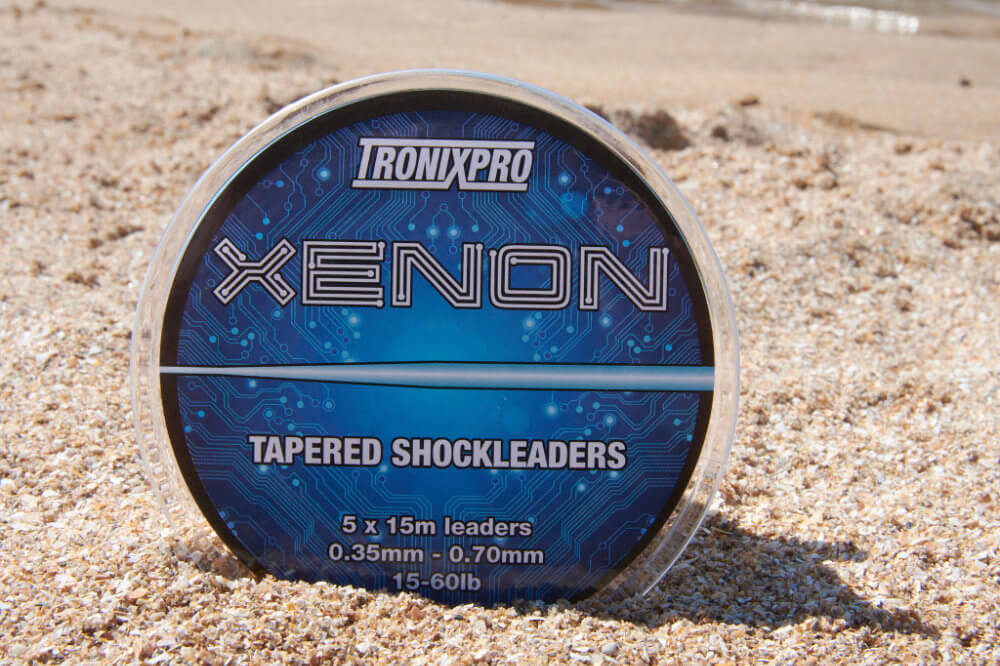
Simple Shock Leader to Casting Weight Formula
There is a simple formula we can follow that explains the minimum breaking strain of shock leader we need to use to suit various lead weights.
1oz = 10lbs
2oz = 20lbs
3oz = 30lbs
4oz = 40lbs
5oz = 50lbs
6oz = 60lbs
7oz – 70lbs
8oz = 80lbs
The table indicates the minimum breaking strain of shock leader needed to cast those specific weights safely. However, when using longer 12ft plus beachcasters that generate faster tip speeds and increased casting power, experienced anglers will increase the shock leader breaking strain by another 10lbs. Effectively, 60lbs for 5oz weights, 70lbs for 6oz weights, and so on. These being a logical choice for these heavier weights that create much more pressure on the leader when power casting.
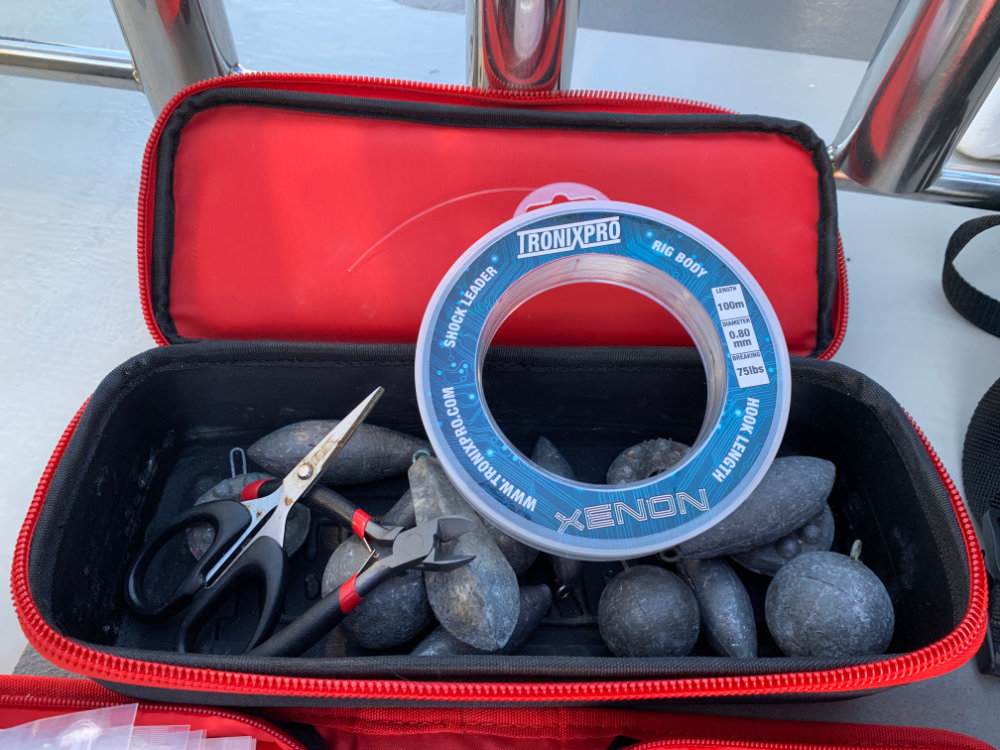
Shock Leader Length
Getting the length of the shock leader correct is vital to safe and secure casting. Get it wrong and you will either pressure the weaker reel line resulting in a crack off or create issues with the leader knot catching in the rings again making a crack-off much more likely.
In all cases the simplest way to get the leader length absolutely correct is to put the rod together and put the reel on the rod. Run the reel line through the rings then attach your shock leader. Wind the leader knot to the reel. Now count the leader knot round the reel spool eight times as the leader winds on to the spool. At the rod tip cut the leader to leave another 3ft of leader beyond the tip ring. This is the best overall length for any shock leader on any surf casting rod.
The eight turns around the reel spool creates no pressure on the weaker reel line or the leader knot when the lead is initially released, and the shock leader tightens. As the leader tightens and the spool starts to revolve, it is important that the leader knot is off the spool and through the rod rings before the reel spool hits full speed. If the shock leader was much longer than eight turns around the spool, the likelihood is, that when full power casting, the leader knot would catch in the butt or second ring and increase the chances of a crack-off. When the spool hits full power This critical length of leader applies to both multiplier reels that have a revolving spool, and fixed spool reels with a static spool.
If you’re in a situation, say when fishing off rocks or man-made structure where long range power casting is not needed, then a longer leader up to twice the length of the rod may be used as the reduced power and lead speed still allows the leader knot off the spool without it catching in the rod rings. This allows you to lift or play out bigger fish when the fish are some distance away from you and may need to be lifted upwards for landing.
Leader Knots
We’ll just give reference to which knots to use as there are so many, but three knots will cover all bases.
Albright Knot
For braid lines up to 30lbs, to join the leader to the reel line use the Albright Knot. It’s a relatively simple knot to tie and tightens down neatly to form a knot that is streamlined and passes through the rod rings with minimal contact.
- Form an open loop in the leader about 2-inches long and hold the loop together in your fingers.
- Pass the reel braid line through the loop from the underneath.
- Using the tag end of braid, wrap this around the loop 10 times back towards the point of the loop.
- Pass the tag end back through the loop the same way it came in.
- Now pull on the reel line to draw the knot slowly together with a little saliva for lubrication and cut the tag ends off.
Standard Leader Knot
For mono lines and leaders, for normal fishing, the standard Shock Leader knot is good.
- Tie a single overhand in the end of the leader.
- Pass the reel line through the still open single overhand knot and semi tighten this.
- Now form a loop your side of the leader, trapping both the top of the loop and the leader in your fingers then take the tag end through the loop 5 times and draw the reel line to just tighten the knot. This knot is the 5-Turn Grinner knot.
- Using pliers, grip the tag end of the leader above the overhand knot and using the other hand on the leader pull the knot tight keeping good tension on it for a few seconds to fully close the knot.
- Gently pressure the 5-Turn Grinner knot to position it tight up to the overhand knot and pull it tight holding it under tension again to fully close it. You can lubricate the knots with saliva or lip Solve prior to closing to make the tightening of the knots easier.
Tournament Leader Knot
For real power casting when using off-the-ground or pendulum casting styles the full Tournament Leader Knot is the one to use but takes a little practice.
- Tie in a single overhand knot in the end of the leader and leave it open.
- In the end of the reel line form a double loop about 8-inches long and close the loop using a Figure-of-Eight Knot.
- Pass the loop only through the open overhand leader knot but not the Figure-of-Eight knot which stays below the overhand knot.
- Using the loop tie a 4-Turn Grinner knot around the leader.
- Tighten up the Overhand Knot with the pliers by pulling the tag end, now tighten up the Grinner knot pulling it down the leader until it sits fully tight up to the Overhand Knot.
This leaves you with a short section of doubled line between the Figure-of-Eight Knot and the completed leader knot. This acts like a shock absorber, plus the loop Grinner Knot is a much stronger knot that really grips the leader material and spreads the pressure more.
Shock Leader Colour
In clear seas with good clarity and fishing in daylight, use a clear mono leader. The clear mono stops fish approaching the baited rig from spooking if the leader line is lifting in the wave surges. Some anglers also choose a yellow line for fishing over sand, or a dark coloured leader when fishing into rocks and weed beds during the day.
At night a bright coloured leader is a big advantage. Leaders in Hi-Vis yellow, red, or orange can be easily seen in your headlight beam when fish are in the surf just prior to landing and you can then easily gauge how far out they are. The same applies when rock fishing and fishing off piers and breakwaters at night.
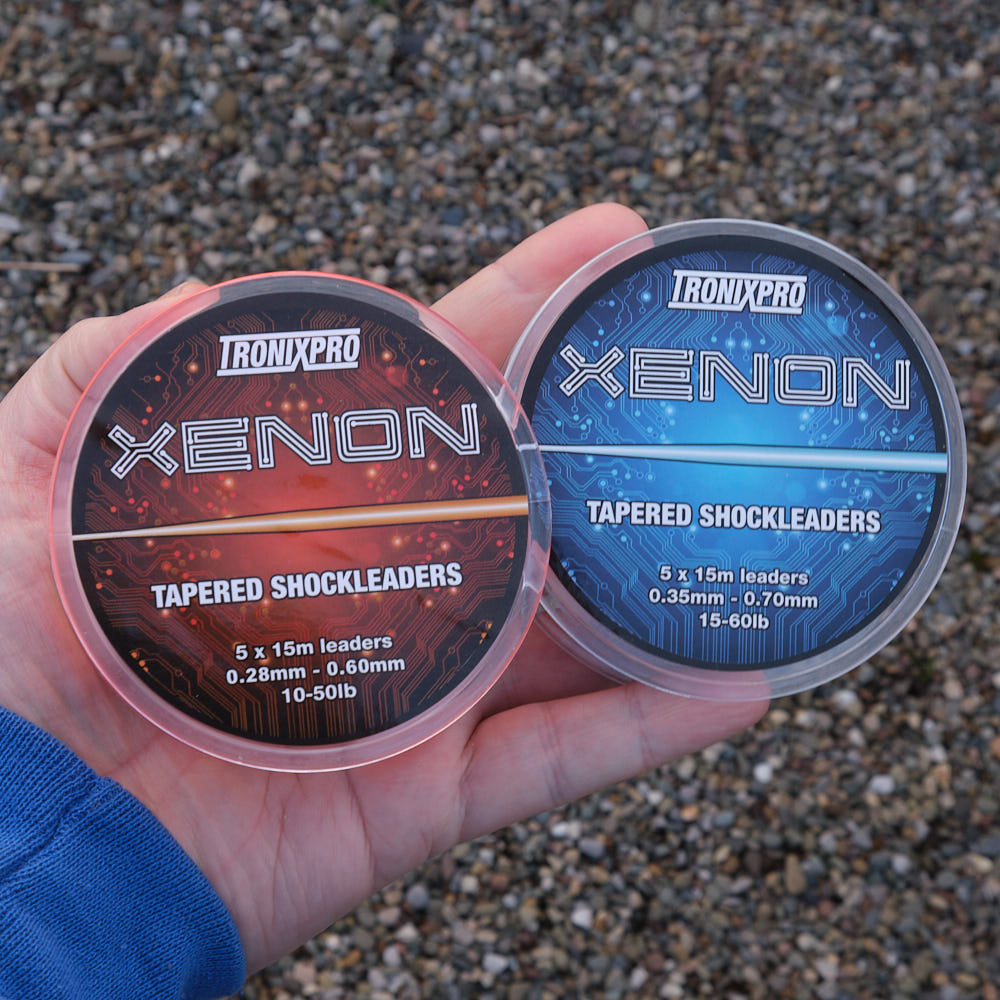
Tapered Leaders
The other option of shock leader is to buy ready-to-go tapered leaders. These are typically 15-metres in length and literally taper from 15lbs to 50lbs and 60lbs at the point, also 18lbs to 70lbs and 26lbs to 80lbs. The lighter end of the tapered leader ties to the reel line of the same breaking strain and when using small knots such as two 5-turn Grinner knots back-to-back, these create minimal friction through the rod rings.
Tronixpro also offers a tapered leader in the same sizes that utilises a clear section at the point nearest the rig so as not to spook fish, but then this forms into a bright orange section nearest the rod tip for easy identification when reeling in. It’s the best of both worlds!
-
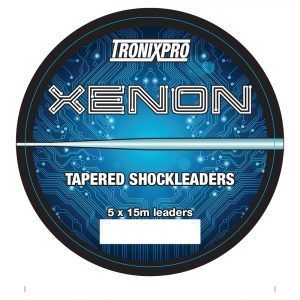 Tronixpro Xenon Tapered Leaders£7.99
Tronixpro Xenon Tapered Leaders£7.99 -
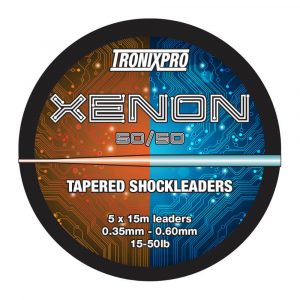 Tronixpro Xenon Tapered Leader 50/50£7.99
Tronixpro Xenon Tapered Leader 50/50£7.99 -
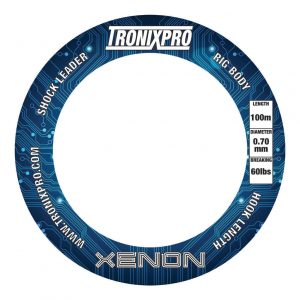 Tronixpro Xenon Leader£6.99 – £9.99
Tronixpro Xenon Leader£6.99 – £9.99
Summing Up
As we’ve seen, shock leaders are essential for safety reasons, but also, they contribute to our fishing results by increasing casting distance plus can be used to give a visual separation line between the rig and the main reel line.
It pays to regularly check your leaders while fishing for abrasion and cuts and replace as necessary.
Another good tip is to occasionally check the leader knots, especially if you’ve got snagged and pulled for a break or been landing several bigger than average fish.


